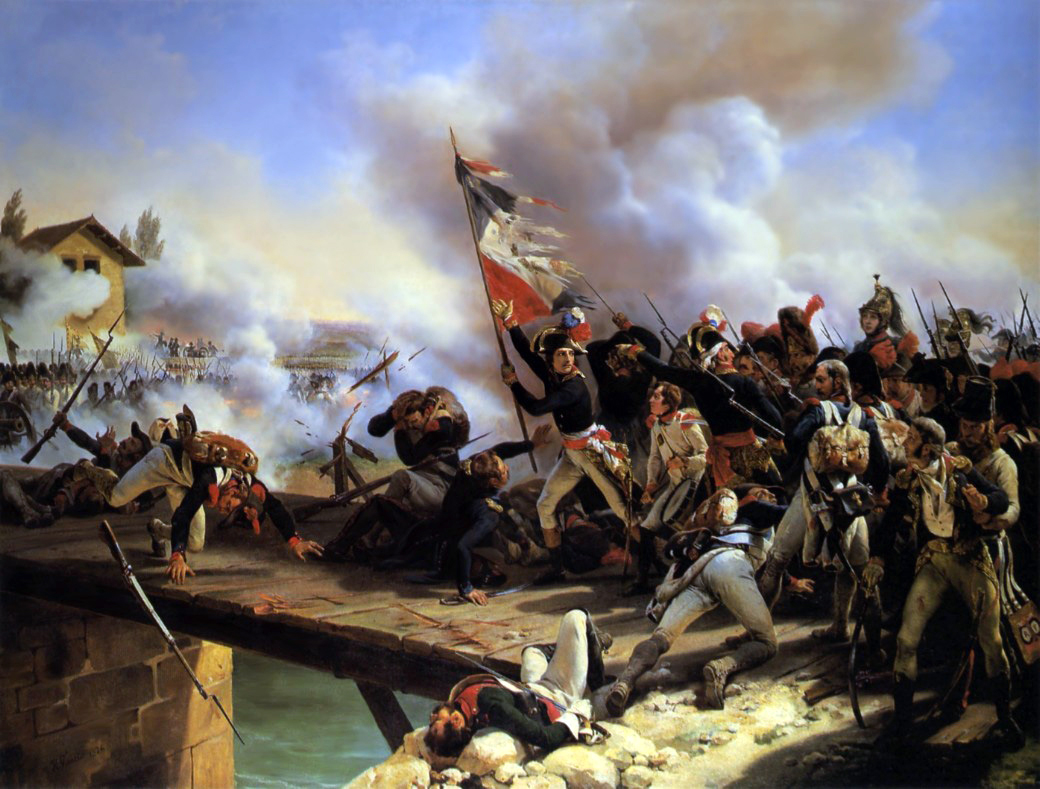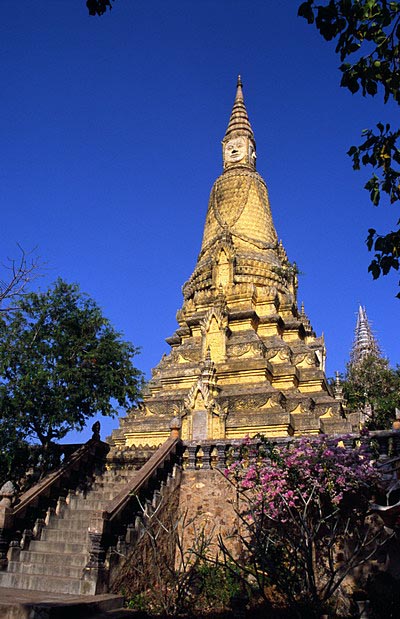|
Outey II
Outey II ( km, ឧទ័យទី២; 1740 – 1777) was king of Cambodia from 1758-1775. He reigned under the name of Outeyreachea II, Reameathipadei IV or Neareayreachea II. Outey was the oldest son of Prince Outeyreachea (1707 - 1753) and Princess Peou, a daughter of King Ang Em, which made him heir to both rival branches of the Varman dynasty, since Outey's grandfather was King Ang Tong, who had ruled Cambodia. When Outey was born in 1740, one year after the Vietnamese were expelled by the Siamese army, Chey Chettha's son King Thommo Reachea was ruling Cambodia for the third time in his life, until he died in 1747. Thommo Reachea son and heir was murdered by a brother, the ministers chose a third brother as King, Ang Tong in 1748, but after being attacked by his relative Satha and a Vietnamese army, he fled to Siam. During his exile, the people in Cambodia drove out the Vietnamese once again, and chose Chey Chettha V as King, who after ruling Cambodia for six years, died in ... [...More Info...] [...Related Items...] OR: [Wikipedia] [Google] [Baidu] |
List Of Kings Of Cambodia
The monarchy of Cambodia is the head of state of the Cambodia, Kingdom of Cambodia. In the contemporary period, the King's power has been limited to that of a symbolic figurehead. The monarchy had been in existence since at least 68 AD except during its abolition from 1970 to 1993. Since 1993, the King of Cambodia has been an elected monarch, making Cambodia one of the few elective monarchy, elective monarchies of the world. The king is elected for life by the Royal Council of the Throne, which consists of several senior political and religious figures. Candidates are chosen from among male descendants of King Ang Duong who are at least 30 years old, from the two royal houses of Cambodia (the House of Norodom and the House of Sisowath). Role Cambodia's constitution, promulgated in 1993 stipulated the king's role as a mainly ceremonial one. It declared that the king "shall reign, but not govern" as well as being the "symbol of national unity and continuity". The king perfo ... [...More Info...] [...Related Items...] OR: [Wikipedia] [Google] [Baidu] |
Taksin
King Taksin the Great ( th, สมเด็จพระเจ้าตากสินมหาราช, , ) or the King of Thonburi ( th, สมเด็จพระเจ้ากรุงธนบุรี, ; ; Teochew dialect, Teochew: Dên Chao; April 17, 1734 – April 7, 1782) was the only King of Thailand, king of the Thonburi Kingdom. He had been an aristocrat in the Ayutthaya Kingdom and then was a major leader during the liberation of Siam from Myanmar, Burmese occupation after the Burmese-Siamese War (1765-1767), Second Fall of Ayutthaya in 1767, and the Taksin's reunification of Siam, subsequent unification of Siam after it fell under various warlords. He established the city of Thonburi as the new capital, as the city of Ayutthaya had been almost completely destroyed by the invaders. His reign was characterized by numerous wars; he fought to repel new Burmese invasions and to subjugate the northern Thai kingdom of Lanna, the Laotian principalities, and a threatening ... [...More Info...] [...Related Items...] OR: [Wikipedia] [Google] [Baidu] |
1796 Deaths
Events January–March * January 16 – The first Dutch (and general) elections are held for the National Assembly of the Batavian Republic. (The next Dutch general elections are held in 1888.) * February 1 – The capital of Upper Canada is moved from Newark to York. * February 9 – The Qianlong Emperor of China abdicates at age 84 to make way for his son, the Jiaqing Emperor. * February 15 – French Revolutionary Wars: The Invasion of Ceylon (1795) ends when Johan van Angelbeek, the Batavian governor of Ceylon, surrenders Colombo peacefully to British forces. * February 16 – The Kingdom of Great Britain is granted control of Ceylon by the Dutch. * February 29 – Ratifications of the Jay Treaty between Great Britain and the United States are officially exchanged, bringing it into effect.''Harper's Encyclopaedia of United States History from 458 A. D. to 1909'', ed. by Benson John Lossing and, Woodrow Wilson (Harper & Brothers, 1910) p17 ... [...More Info...] [...Related Items...] OR: [Wikipedia] [Google] [Baidu] |
Cambodian Buddhist Monarchs
Cambodian usually refers to: * Something of, from, or related to the country of Cambodia ** Cambodian people (or Khmer people) ** Cambodian language (or Khmer language) ** For citizens and nationals of Cambodia, see Demographics of Cambodia ** For languages spoken in Cambodia, see Languages of Cambodia Cambodian may also refer to: Other * Cambodian architecture * Cambodian cinema * Cambodian culture * Cambodian cuisine * Cambodian literature * Cambodian music * Cambodian name * Cambodian nationalism * Cambodian descendants worldwide: ** Cambodian Americans ** Cambodian Australians ** Cambodian Canadians ** Cambodians in France See also * *List of Cambodians {{Short description, none This is a list of notable Cambodian people, persons from Cambodia or of Khmer descent. * Adda Angel * Am Rong * Ampor Tevi * Arn Chorn-Pond * Beat Richner * Bérénice Marlohe * Bour Kry * Chan Nak * Chan Sy * Chantho ... {{disambig Language and nationality disambiguation pages [...More Info...] [...Related Items...] OR: [Wikipedia] [Google] [Baidu] |
18th-century Cambodian Monarchs
The 18th century lasted from January 1, 1701 ( MDCCI) to December 31, 1800 ( MDCCC). During the 18th century, elements of Enlightenment thinking culminated in the American, French, and Haitian Revolutions. During the century, slave trading and human trafficking expanded across the shores of the Atlantic, while declining in Russia, China, and Korea. Revolutions began to challenge the legitimacy of monarchical and aristocratic power structures, including the structures and beliefs that supported slavery. The Industrial Revolution began during mid-century, leading to radical changes in human society and the environment. Western historians have occasionally defined the 18th century otherwise for the purposes of their work. For example, the "short" 18th century may be defined as 1715–1789, denoting the period of time between the death of Louis XIV of France and the start of the French Revolution, with an emphasis on directly interconnected events. To historians who expan ... [...More Info...] [...Related Items...] OR: [Wikipedia] [Google] [Baidu] |
Que Sais-je ?
"Que sais-je?" (QSJ) (; Literally: "What do I know?", ) is an editorial collection published by the Presses universitaires de France (PUF). The aim of the series is to provide the lay reader with an accessible introduction to a field of study written by an expert in the field. As such, they are a good example of ''haute vulgarisation'' (high popularization). The sentence "Que sais-je?" is taken from the works of French essayist Michel de Montaigne. Started in 1941 by Paul Angoulvent (1899–1976), founder of the Presses Universitaires de France, the series now numbers over 3,900 titles by more than 2,500 authors, and translated in more than 43 languages. Somes titles have sold more than 300,000 copies (namely by Piaget). Each year, 50 to 60 new titles are added to the collection, which comprises ten different series. As such, it easily constitutes the world's largest running 'encyclopedia' in paperback format. The range of subjects is truly encyclopedic, covering everything fro ... [...More Info...] [...Related Items...] OR: [Wikipedia] [Google] [Baidu] |
Achille Dauphin-Meunier
Achille Dauphin-Meunier (1906–1984) was a French economist. He wrote on US-Laotian relations. He was a member of the Club de l'horloge The Carrefour de l'Horloge (literally ''The Clock Crossroad''), formerly Club de l'Horloge (1974–2015), is a French far-right national liberal think tank founded in 1974 and presided by Henry de Lesquen. The organization promotes an "integral n .... References Carrefour de l'horloge people 1906 births 1984 deaths 20th-century French economists {{France-economist-stub ... [...More Info...] [...Related Items...] OR: [Wikipedia] [Google] [Baidu] |
Uparaja
Uparaja or Ouparath, also Ouparaja ( my, ဥပရာဇာ ; km, ឧបរាជ, ; th, อุปราช, ; lo, ອຸປຮາດ, ''Oupahat''), was a royal title reserved for the viceroy in the Buddhist dynasties in Burma, Cambodia, and Laos and Thailand, as well as some of their minor tributary kingdoms. Burma The Great Deputy King, in full Maha Uparaja Anaudrapa Ainshe Min, incorrectly interpreted as Crown Prince by Europeans, and addressed as His Royal Highness, was the single highest rank among the Min-nyi Min-tha, i.e. princes of the royal blood. It is shortened to Einshay Min (, ). However, the position was not reserved for the highest birth rank (if there is one, ''Shwe Kodaw-gyi Awratha'', i.e. eldest son of the sovereign, by his chief Queen), nor did it carry a plausible promise of succession, which was usually only settled in an ultimate power struggle. Cambodia The word Ouparach ( km, ឧបរាជ) is derived from both Sanskrit and Pali languages, literall ... [...More Info...] [...Related Items...] OR: [Wikipedia] [Google] [Baidu] |
Coregency
A coregency is the situation where a monarchical position (such as prince, princess, king, queen, emperor or empress), normally held by only a single person, is held by two or more. It is to be distinguished from diarchies or duumvirates such as ancient Sparta and Rome. Co-principality is a distinct but related system employed in contemporary Andorra, where monarchical power is formally divided between two rulers. Historical examples Coregencies were common in the Hellenistic period; according to one scholar, they "can usually be explained as a means of avoiding crises of succession or internal conflict, and of strengthening dynastic identity and ideology." Other examples include the coregency of Frederick I of Austria and Louis the Bavarian over the Kingdom of Germany. ''Jure uxoris'' Kings in Kingdoms such as Spain and Portugal can also be found (Ferdinand V and Isabella I of Castile, Philip I and Joanna of Castile, Peter III and Maria I of Portugal, etc.). In Navarre, ... [...More Info...] [...Related Items...] OR: [Wikipedia] [Google] [Baidu] |
Phnom Penh
Phnom Penh (; km, ភ្នំពេញ, ) is the capital and most populous city of Cambodia. It has been the national capital since the French protectorate of Cambodia and has grown to become the nation's primate city and its economic, industrial, and cultural centre. Phnom Penh succeeded Angkor Thom as the capital of the Khmer nation but was abandoned several times before being reestablished in 1865 by King Norodom. The city formerly functioned as a processing center, with textiles, pharmaceuticals, machine manufacturing, and rice milling. Its chief assets, however, were cultural. Institutions of higher learning included the Royal University of Phnom Penh (established in 1960 as Royal Khmer University), with schools of engineering, fine arts, technology, and agricultural sciences, the latter at Chamkar Daung, a suburb. Also located in Phnom Penh were the Royal University of Agronomic Sciences and the Agricultural School of Prek Leap. The city was nicknamed the "Pearl of As ... [...More Info...] [...Related Items...] OR: [Wikipedia] [Google] [Baidu] |
Oudong
( km, ឧដុង្គ; also romanized as Udong or Odong) is a former town of the post-Angkorian period (1618–1863) situated in present-day ''Phsar Daek'' Commune, Ponhea Lueu District, Kandal Province, Cambodia. Located at the foothill of the mountain Phnom Oudong, also known as Phnom Preah Reach Troap ( km, ភ្នំព្រះរាជ្យទ្រព្យ), about 35 km northwest of the modern capital Phnom Penh via National Road No. 5, Oudong was a royal residence and Cambodia's capital for almost 250 years until 1866. A monumental royal necropolis of sovereigns of several centuries is scattered on top of the prominent bisected mountain, which runs from the southeast to the northeast. Etymology The city's name is derived from the Sanskrit word "" ( sa, उत्तुङ्ग), meaning tall, which probably refers to the mountain. As it had gained religious merit and significance it might have undergone extension towards: "great" or "supreme". History Oudong was ... [...More Info...] [...Related Items...] OR: [Wikipedia] [Google] [Baidu] |
.jpg)




